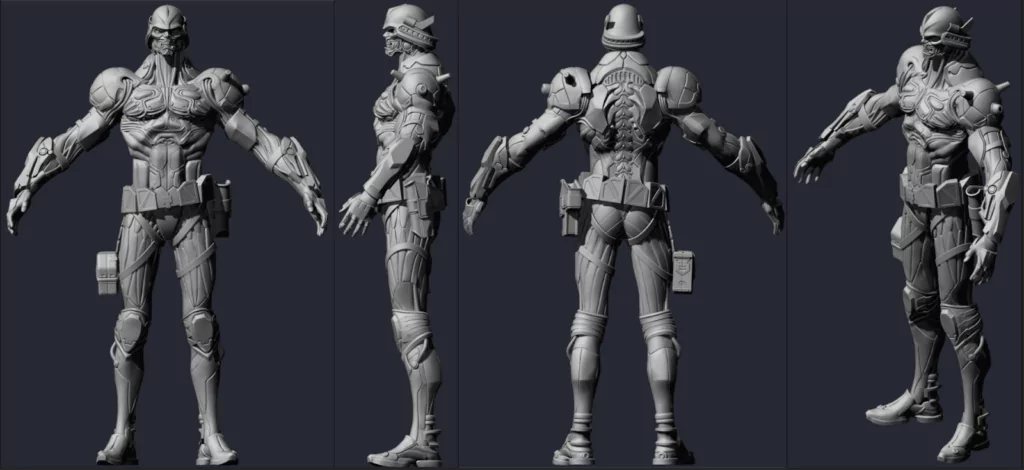In the realm of digital media, the role of the 3D character designer is becoming increasingly pivotal. The job involves much more than simply crafting an attractive 3D model; it demands the creation of a personality, a story, and a virtual life within that character. The successful design of a 3D character can be a significant factor in the success of a video game, film, or animated series, so it’s a role that carries immense responsibility.
The 3D Character Design Process
The process of designing a 3D character often begins with concept art and sketches. Artists work to visualize a character’s appearance, posture, facial features, and clothing. This initial concept stage provides a visual guide as the 3D model starts to take shape.
The next step is modeling, which is the process of constructing the character in 3D space. Using specialized software, designers sculpt the character’s shape, ensuring that every detail from the initial concept is included. One of the key considerations during this phase is topology, which is how the mesh of polygons that forms the character is structured. Good topology ensures that a character can be animated smoothly.
After modeling, the character goes through texturing, where colors and patterns are added to the model. This process includes creating realistic skin textures, clothing materials, and other surface details that make the character appear more lifelike. Lighting and shading techniques also play a crucial role in enhancing the character’s realism.
Finally, rigging is performed, which is the process of adding a skeleton to the model. These skeletons allow the characters to move and interact within their environments. It’s a crucial step in bringing a character to life and requires careful attention to ensure natural, fluid movements.
Creativity and Storytelling in 3D Character Design
One of the most exciting aspects of 3D character design is the creative freedom it offers. Designers can create characters from their wildest imaginations, from mythical creatures to futuristic robots. However, these designs must serve a purpose within the context of their story or game.
Every design element of a character, from their physical attributes to their attire, contributes to their backstory and personality. A skilled 3D character designer will consider the character’s role within the narrative, their origins, their motives, and how these aspects can be visually communicated to the audience.
For example, consider a character who is a seasoned space explorer. Elements such as a futuristic suit, worn with patches from previous missions, and a confident posture can immediately convey the character’s profession and experience to the audience.
The Role of Technology
Advancements in technology have dramatically changed the landscape of 3D character design. With the advent of tools such as ZBrush and Maya, designers can create characters with an unprecedented level of detail and realism.
Virtual Reality (VR) and Augmented Reality (AR) technologies are also creating new opportunities and challenges for 3D character designers. Designing for VR or AR requires careful consideration of how a character interacts with the user and their environment, requiring a heightened focus on aspects like scale, movement, and interaction.
The Future of 3D Character Design
The future of 3D character design is bright, with the field poised for continued growth and innovation. As technologies like artificial intelligence and machine learning continue to advance, we may see these tools used to automate parts of the character design process, such as generating realistic textures or optimizing character topology.
However, the heart of 3D character design will always lie in creativity, artistry, and storytelling. As we move forward into the future, the role of the 3D character designer will continue to be crucial in crafting compelling digital experiences, captivating audiences with characters that are not only visually stunning but also rich in personality and depth.
The Value of Collaboration in Character Design
The process of creating a 3D character isn’t usually a solitary endeavor. It often involves a multidisciplinary team of artists, animators, and writers. Collaboration plays a vital role in creating characters that are visually appealing, animation-ready, and meaningful within the story’s context.
Designers must work closely with animators to ensure the models they create can move and behave as intended. This means understanding the principles of animation and considering how the character’s design will affect its movement. For example, a character with large, exaggerated features may need a different approach to animation than one with more subtle, realistic details.
Writers or narrative designers also contribute significantly to the character design process. They often create the backstory and personality of the character, which the designers must translate into visual elements. The designers and writers must communicate effectively to ensure the character’s design aligns with their narrative role.
Mastering the Software
3D character design requires proficiency in various software applications. Programs like Autodesk Maya and 3ds Max are widely used for 3D modeling and animation. ZBrush is a popular choice for digital sculpting, allowing designers to create models with highly detailed features and textures. Substance Painter and Adobe Photoshop are often used for texturing and adding detailed artwork to the character models.
Understanding and mastering these tools is essential for any 3D character designer. However, it’s also important to remember that software is merely a tool to bring your artistic vision to life. The heart of 3D character design lies in creativity, storytelling, and the ability to create characters that resonate with audiences.
The Impact of 3D Character Design
3D character design plays a critical role in various industries, including film, gaming, advertising, and more. Well-designed characters can make a story more engaging, a game more immersive, or an advertisement more impactful. They can evoke emotions, create connections, and make digital experiences more human.
In the film and gaming industries, 3D characters often become iconic figures recognized worldwide, such as the titular characters of Pixar’s “Toy Story” or Naughty Dog’s “The Last of Us”. In advertising, 3D characters can become mascots for brands, helping to create a distinct brand identity.
Final Thoughts
3D character design is a fascinating blend of art, technology, and storytelling. It’s a challenging field, requiring a wide range of skills and a deep understanding of character and narrative. However, it’s also a field full of opportunities to create something truly unique and impactful.
As we look to the future, the role of 3D character designers will only continue to grow in importance. With the rise of virtual reality, augmented reality, and other immersive technologies, the demand for skilled character designers is set to rise. Those who can combine technical skills with a strong sense of creativity and narrative will be at the forefront of creating the digital experiences of tomorrow.












